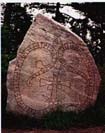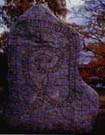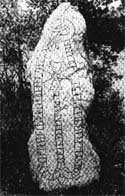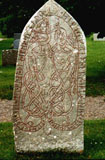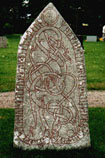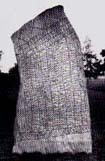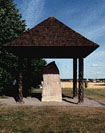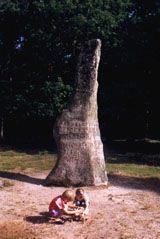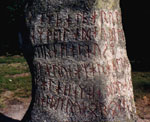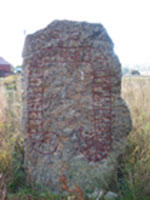Some Old Runestones
The Jarlabanke Stones
A guy named Jarlabanke, whom probably was a member of the local aristocracy, raised these stones. His stones, because there are several of them, are interesting in many ways. These stones are a striking piece of evidence that you didn't have to be dead to have a runestone raised for you. The inscription of one of them says:
Jarlabanki had this stone put up in his own lifetime. And he made this causeway for his soul's sake. And he owned the whole of Täby by himself. May god help his soul.
A causeway is a type of bridge and his bridge is still there and in use! You can see it with the runestones two and two on each side of the bridge in Täby some 30 km north of Stockholm. Täby is a rather large municipality with some 60000 inhabitants today and the area of it is quit large so it wasn't a small piece of land that he owned.
The phrase "May god help is soul" is quit common on runestones. Many runestones are raised when Christianity had arrived to Sweden and many of them have a cross on them.
The Gripsholm Runestone
This runestone is one of several that mention an expedition mounted by a man called Ingvar the Far-travelled. According to a story written in Iceland 200 years after the journey actually happened, Ingvar arranged the big journey in the first half of the 11th century. It could have been up to 30 ships that travelled via the rivers in Russia to a goal somewhere in Serkland, a land of dark-skinned peoples like Arab caliphates. the south. The journey wasn't successful at all. According to the story almost no one came back from the journey. There are about 30 runestones around the Lake Mälaren region in Sweden that mention people who embarked with Ingvar journey. Of all these runestones not a single one tell us that the person came back from the journey. The inscription of this runestone tell us
"Tola had this stone set up in memory of her son Harald, Ingvar's brother. Like men they went far to seek gold. And in the east they fed the eagle. Died in the south, in Serkland"
The Väsby runestone
This
runestone is one of several that tell us about a man whom have been given
danageld. This time it was Knut the king of England that has given it
to Alle and his "friends". Perhaps English readers know Knut
better as Canute. The inscription says:
"Alle had this stone put up in his own honour. He took Knutr's danegeld in England. May god help his soul"
The Sandby runestones
You
can find these two runestones in the churchyard at Sandby in the island
of Öland in Sweden. The stones don't go in to the top ten lists of
the most famous runestones but both of them are very beautiful and have
a little piece of history to tell. Here is the inscription of them:
"Gudfast and Helgum and Nenne, mother and sons, they had this stone put up after is father Sven"
"Those brothers put up this memorial after their sister Afrid and their father Sven"
It's a good guess that these runestones have been standing close to each other. The inscription on one of them, those brothers, must refer to the names on the other one. Why Afrid, the sister, wasn't mentioned on the first one is a riddle. Perhaps she didn't lived in the region and therefore wasn't involved with the first stone. When her brother heard that she was dead they put up another stone for her and then again they mentioned their father Sven.
The runestone at Rök
This
runestone is perhaps the most famous one of all the known runestones.
It's a piece of an old story or rather, pieces from several old stories,
probably well known in the beginning of the Viking Age but which meaning
unfortunately is forgotten many houndred years ago. The inscription that
is the longest known runic inscription in the world cutted in stone, has
many different traits of characters. A big part of the inscription is
poetry but there is also parts that are written clandestinely. The inscription
is hard to understand. You can see the stone at Rök in the province
of Östergötland in Sweden.
"In memory of Vemothr/Vamothr stand these runes.
And Varinn coloured them, the father, in memory of his dead son.
I say the folktale / to the young men, which the two war-booties were, which twelve times were taken as war-booty, both together from various men.
I say this second, who nine generations ago lost his life with the Hreidgoths; and died with them for his guilt. Thjothrikr the bold, chief of sea-warriors, ruled over the shores of the Hreithsea.
Now he sits armed on his Gothic horse, his shield strapped, the prince of the Maerings.
I say this the twelfth, where the horse of Gunnr sees fodder on the battlefield, where twenty kings lie.
This I say as thirteenth, which twenty kings sat on Sjolund for four winters, of four names, born of four brothers: five Valkis, sons of Hrathulfr, five Hreithulfrs, sons of Rugulfr, five Haisl, sons of Horthr, five Gunnmundrs/Kynmundrs, sons of Bjorn.
Now I say the tales in full. Someone.....
I say the folktale / to the young men, which of the line of Ingold was repaid by a wife's sacrifice.
I say the folktale / to the young men, to whom is born a relative, to a valiant man.
It is Velinn.
He could crush a giant.
It is Velinn....
I say the folktale / to the young men: Thor.
Sibbi of Ve, nonagenarian, begot a son."
The Björketorp runestone
This
runestone is one of my favourite one's. The runes on it are the old 24
runerow and the inscription speaks about runes full of might and the one
who breaks it will become an "angry?" man for the rest of his
life. The runestone stands between two other big stones without any runes.
Around these stones are many graves and perhaps the runes want to protect
the graves from grave robbers. It is very uncommon that runestones stand
among graves but the runestones with the old 24 runerow on them have other
characters and the younger stones. The place around the runestone and
the graves breathes harmony, piece, calm and silence but the area also
put a sort of spell on you. It's hard to explain but perhaps the runes
on the stone have some influence on the spot, you never know. No one has
dared to destroy the grave or the stones for more than thousand years.
It's a place well worth a visit you won't regret it. If you want to see
it stands at Tving in Blekinge, Sweden. The inscription says:
"The secret of powerful runes I concealed here, strength runes. The one that break this memorial shall constantly be plagued by wrath. Treacherous death will hit him. I predict destruction. "
The Jursta runestone
The
runestone at Jursta will most likely not win the first price as the most
fascinating runestone in the world. The ornament is simple and the eyes
at the
head of the snake are rather rough done. However, there is one interesting
thing about the ornaments.
According
to the Aesir religion the world holds together by a huge snake. The
snake surrounds the world and the snake has its tail in a firm grip in
its mouth. If
the snake looses its grip the world will fall apart and that will be the
end of
the mankind.
If you study runestone more closely, you will find that almost every runestone with one or more snakes on them have snakes that wriggle around each other or themselves. If there is only one snake on the stone it will almost ever cross itself in one point. If it doesn’t there is some kind of other connection between the different parts of the snake, which results in that the middle area of the runestone is surrounded by ornaments. If there should be an opening in the outer ornament it will symbolize that the snake had lost the grip around its tail and the world will fall apart. We don’t want that to happen, do we?
What about the Jursta runestone, did woman behind the order of the stone really the world to break down? Probably not, the explanation must be another. Perhaps they didn’t bother about the rules how to ornament a runestone or perhaps they didn’t know about the legend. Most likely the reason is the first one, because at the top of the stone there is an iron, which shows us that, the man behind the runestone was Christian. The worship of the Aesirs belonged to the past and it was a new era, so why follow the old rules?
The inscription of the runestones says:
"Gynna raised this stone after Saxe, Halvdan son. "

